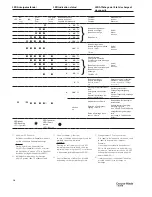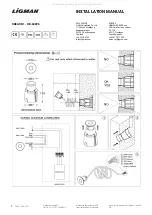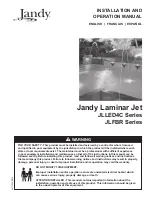
7
GB
GB
Explosion protected LED-exit luminaire
Series: EXIT N
Pay attention to the proper fit of the
remaining sealing insert in the certified cable
gland.
In case of unused cable entries, remove their
protective cover and close the entries with a
blanking plug (torque of 1.7 Nm).
When closing the gland with a blanking plug,
always use both sealing inserts!
When metal cable entries are used, the
protective caps of the unused entries are to
be removed and the entries to be closed with
certified Ex blanking plugs (min. IP66)!
Attention!
Only fix laid cable may be used for connec
tion!
If cable glands from other manufacturer are
used the instructions regarding strain relief
and clamping capacity must be observed!
Connect the conductors to the terminals L, N
and PE in accordance with the terminal marking
(see fig. 2).
Take care not to pinch any conductors.
Install the protective cover with the four screws.
Tighten the screws only hand-tight!
5. Function
5.1 Display
Luminaires equipped with LED-lightsources are
used normally as exit-luminaires due to the light
output of the LEDs. Therefor these light fittings
have to be operated continuously (Independent
system mode).
The luminaire is fitted with a microcomputer for
charging and monitoring and with a display
composed of 7 light emitting diodes. The five
green LED’s indicate the battery’s charge state
and available capacity. The red LED signals
possible failures, the yellow LED signals the
emergency operation (fig. 4).
See also page 8: table of LED indication status.
5.2 Adjustment
Because of the light source energy of the LED
diodes, the luminaires are used almost
exclusively as luminaires for emergency exit
signs.
After removing the hood, it is possible to adjust
to two operating positions by means of the small
switch situated on the front of the plate with the
inscription "Drawing 6A".
"Permanent lighting" position
Position "ON", delivery position.
The light goes on in normal service and
emergency situations.
"Emergency lighting" position
Position "OFF", delivery position.
The white LED diodes are off in normal service
conditions.
Loading status and possible sources of
interference will be indicated.
In case of power failure, the white LEDs shine.
The yellow LEDs function in emergency
situations.
The weekly function test and the partial
operating time test, performed every 3
months, will be set in the position ´OFF´.
5.3 Charging
The microcomputer controlled charging system
measures the charging and discharging current
and transmits it to a capacity meter. Five green
light emitting diodes indicate in 20%-steps the
actual charge state of the battery, see fig. 3.
Overcharging is prevented by means of this
charging control dependent on the capacity. Only
the energy drawn is recharged. The so-called
memory effect is thus also prevented.
At temperatures below -5°C and above +35°C
the battery will not be fully charged for
electrochemical reasons.
During the charging process the leading flashing
LED indicates the amount of capacity charged so
far. The LED’s for the capacity already charged
indicate continuously (fig. 3). The charging
process is complete when all five green LED’s
are illuminated and none is flashing.
The LED display takes into account the decline in
the capacity of the battery: i.e., if the indication
does not go beyond the 3rd green LED even
after an extended charging period, the available
capacity is between 40 and 60%.
This indication is updated again on each
emergency lighting operation until the battery is
shut down by the deep discharge protection for
the battery.
The reduction in the battery capacity due to
self-discharge in normal operation is automatical-
ly recharged controlled by the microprocessor.
5.4 Automatic function test
5.4.1 Function test (FT)
A function test (FT) is performed automatically.
5.4.2 Partial operating time test (TBT)
Every 3 months a partial operating time test is
performed. If no emergency lighting operation >
30 min. has occurred during the last 3 months.
During this test emergency lighting operation is
performed for approx. 35 min.
5.5. Emergency lighting operation
Emergency lighting operation is automatically
initiated by the FT+TBT, by mains failure, or
manually by shutting down the mains supply.
During this process the emergency luminaire
marked in red is switched to battery operation.
The residual capacity available is indicated by the
5 green light emitting diodes, see figure 3.
6. Taking into operation
Prior to operation, check the light fitting
for its proper functioning and installation in
compliance with these operating instructions
and other applicable regulations!
Only carry out insulation measurements
between PE and the external conductor L as
well as between PE and N.
– measuring voltage: max. 1 kV AC/DC
– measuring current:
max. 10 mA
Mind: There must no insulation measure
ment be carried out between L and N, since
that would destroy the electronics (mains
input fuse in the unit).
7. Maintenance
Observe the national regulations
applicable to the maintenance, servicing and
test of apparatus for explosive atmospheres
e.g IEC/EN 6007917 as well as the general
rules of engineering!
7.1 Battery replacement
See fig. 5
When the battery shows low capacity because
of ageing the battery has to be changed.
Only use certified genuine CEAG/CCH spare
parts! (See CEAG/CCH spare parts list).
Cut the apparatus off the voltage before
opening it!
Open the luminaire.
Unplug the connection between batterie
printed board.
Unscrew and remove the screws of the
battery housing.
Assemble the new battery in reverse order.
8. Servicing
When servicing, in particular those components
that affect the explosion protection, will have to
be checked, e. g.:
❒
Housing and protective bowl for any cracks
or damages.
❒
Gaskets for their perfect condition.
❒
Terminals and blanking plugs for their firm
fit.
❒
Because of the risk of an electrostatic
charge, the light fitting shall only be cleaned
with a damp, non-fibrous cloth or sponge!
Only use customary household washing-up
liquid diluted in water as specified! The
water temperature may be max. 50°C.
After that, rinse with clear water to prevent
the risk of tension cracks in the protective
bowl!
9. Repair/Overhaul
Repairs that affect the explosion protec
tion, may only be carried out by COOPER
CROUSEHINDS or a qualified electrician in
compliance with the applicable national rules
(IEC/EN 6007919).
Prior to replacing or removing any components,
observe the following:
Cut the apparatus off the voltage before
opening it or carrying out repairs! Only use
certified genuine CEAG/CCH spare parts!
(See CEAG/CCH spare parts list).
Subject to alteration or supplement of this
product series.
Regarding waste disposal, observe the relevant
national regulations! The plastic materials are
marked with material identifications.
Содержание EXIT N Series
Страница 11: ...11 Notizen Notes Remarques...






























